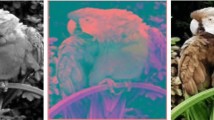Abstract
Color is a powerful descriptor that often simplifies object extraction and identification, and many computer vision systems use color to aid object recognition. However, image colors strongly depend on lighting geometry (direction and intensity of light source) and illuminant color (spectral power distribution). Either small variation in the intensity or the change of scene illumination can dramatically make object color changed. To overcome the lighting dependency problem, a color constancy or normalization algorithm should be used for preprocessing. This paper presents a novel approach to performing color normalization. A nonlinear mapping function is estimated using a neural network. Once the mapping function is found accurately, an image under unknown illumination may be transformed to the image under the predetermined illumination, which will be useful for color image processing. Three groups of experiments were conducted. In our experiments, images are processed by various neural networks and the performance is boosted by using a committee machine, and then the mapping errors are estimated and the results are compared with those of other algorithms. The experimental results demonstrate that the performance of the proposed method is superior to that of other color normalization algorithms.







Similar content being viewed by others
References
Nassau K (1998) Color for science, art and technology. Elsevier, Amsterdam
MacDonald LW, Luo MR (2002) Colour image science: exploiting digital media. Wiley, Chichester
Finlayson GD, Tian GY (1999) Color normalization for color object recognition. Int J Pattern Recognit Artif Intell 13:1271–1285
Jameson D, Hurvich LM (1989) Essay concerning color constancy. Annu Rev Psychol 40:1–22
Barnard K, Cardei V, Funt B (2002) A comparison of computational color constancy algorithms - Part I: Methodology and experiments with synthesized data. IEEE Trans Image Process 11:972
Barnard K, Martin L, Coath A, Funt B (2002) A comparison of computational color constancy algorithms. Part II: Experiments with image data. IEEE Trans Image Process 11:985
Maloney LT, Wandell BA (1986) Color constancy: a method for recovering surface spectral reflectance. J Opt Soc Am A Opt Image Sci Vis 3:29–33
Dzmura M (1992) Color constancy: surface color from changing illumination. J Opt Soc Am A Opt Image Sci Vis 9:490–493
Tominaga S, Wandell BA (1990) Component estimation of surface spectral reflectance. J Opt Soc Am A Opt Image Sci Vis 7:312–317
Craven BJ, Foster DH (1992) An operational approach to color constancy. Vis Res 32:1359–1366
Buchsbaum G (1980) A spatial processor model for object color perception. J Frank Inst 310:1–26
Land EH (1977) The retinex theory of color vision. Sci Am 237:108–129
Forsyth DA (1990) A novel algorithm for color constancy. Int J Comput Vis 5:5–36
Barnard K (2000) Improvements to gamut mapping colour constancy algorithms. Comput Vis Eccv 2000 Pt I Proc 1842:390–403
Tominaga S, Ebisui S, Wandell BA (2001) Scene illuminant classification: brighter is better. J Opt Soc Am A Opt Image Sci Vis 18:55–64
Tominaga S, Wandell BA (2002) Natural scene-illuminant estimation using the sensor correlation. Proc IEEE 90:42–56
Brainard DH, Freeman WT (1997) Bayesian color constancy. J Opt Soc Am A Opt Image Sci Vis 14:1393–1411
Barnard K, Martin L, Funt B (2000) Color by correlation in a three dimensional color space. Presented at 6th European Conference on Computer Vision, Dublin, Ireland
Finlayson GD, Hordley SD, Hubel PM (2001) Color by correlation: a simple, unifying framework for color constancy. IEEE Trans Pattern Anal Mach Intell 23:1209
Rosenberg C, Hebert M, Thrun S (2001) Color constancy using KL-divergence. In: Proceedings of the IEEE international conference on computer vision. Vancouver, Canada
Geusebroek JM, Van den Boomgaard R, Smeulders AWM, Geerts H (2001) Color invariance. IEEE Trans Pattern Anal Mach Intell 23:1338
Sonka M, Hlavac V, Boyle R (1999) Image processing, analysis, and machine vision, 2nd edn. PWS, Pacific Grove
Cheng HD, Jiang XH, Sun Y, Wang JL (2001) Color image segmentation: advances and prospects. Pattern Recognit 34:2259–2281
Finlayson GD, Schiele B, Crowley JL (1998) Comprehensive color image normalization. In: Proceedings of the 5th European conference on computer vision 1, Freiburg, Germany
Lin ZY, Wang JX, Ma KK (2002) Using eigencolor normalization for illumination-invariant color object recognition. Pattern Recognit 35:2629–2642
Courtney SM, Finkel LH, Buchsbaum G (1995) Network simulations of retinal and cortical contributions to color constancy. Vis Res 35:413–434
Funt B, Cardei VC, Barnard K (1997) Neural network color constancy and specularly reflecting surfaces. In: Processing of AIC color 97 II, Kyoto, Japan
Cardei VC, Funt B, Barnard K (2002) Estimating the scene illumination chromaticity by using a neural network. J Opt Soc Am A Opt Image Sci Vis 19:2374–2386
Agarwal V, Gribok AV, Abidi MA (2007) Machine learning approach to color constancy. Neural Netw 20:559–563
Haykin SS (1999) Neural networks: a comprehensive foundation. 2nd edn.: Institute of Electrical and Electronics Engineers, Prentice-Hall, Upper Saddle River
Funt B, Barnard K, Martin L (1998) Is machine colour constancy good enough? Lect Notes Comput Sci 1406:445
Swain MJ, Ballard DH (1991) Color indexing. Int J Comput Vis 7:11–32
Author information
Authors and Affiliations
Corresponding author
Rights and permissions
About this article
Cite this article
Cheng, H.D., Cai, X. & Min, R. A novel approach to color normalization using neural network. Neural Comput & Applic 18, 237–247 (2009). https://doi.org/10.1007/s00521-008-0176-4
Received:
Accepted:
Published:
Issue Date:
DOI: https://doi.org/10.1007/s00521-008-0176-4




